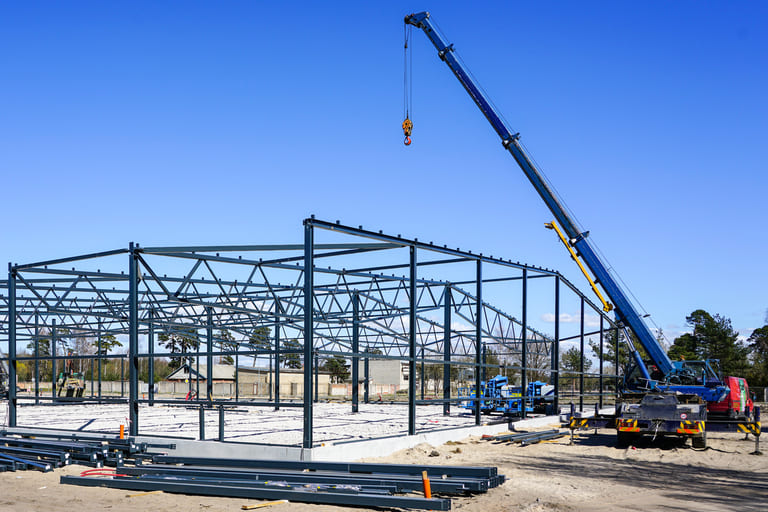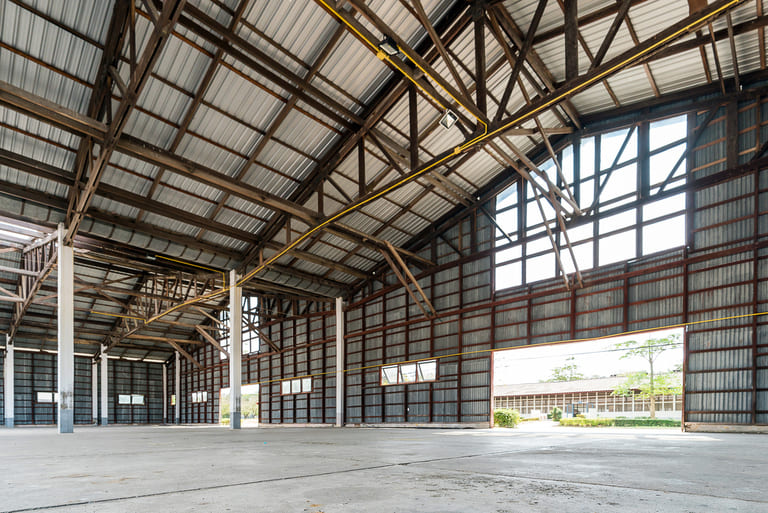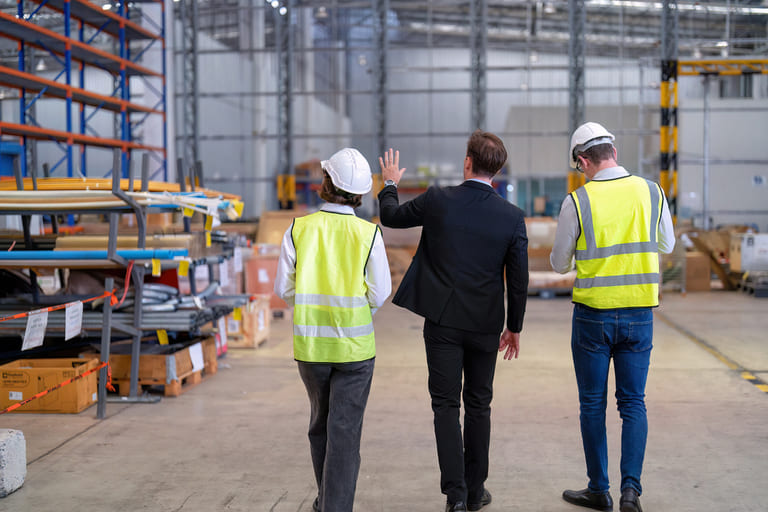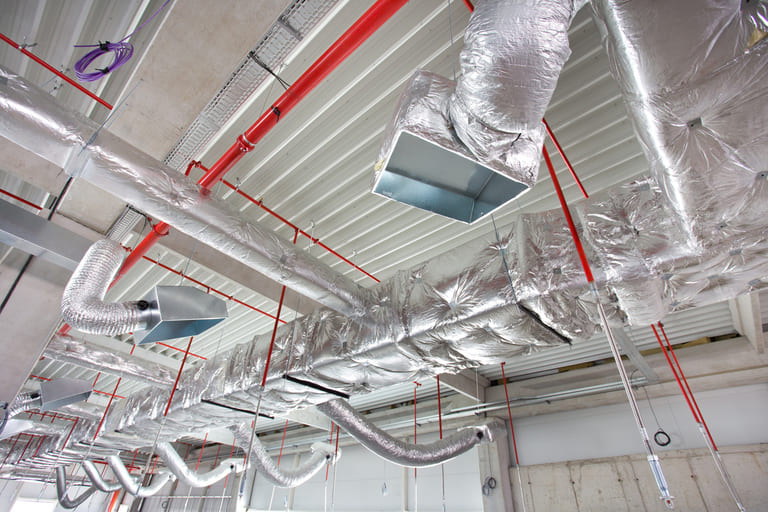

Taiyo Kogyo Column
Checkpoints before rebuilding a warehouse|Detailed explanation of everything from advantages to laws and regulations and precautions.
2025.05.02

There are many reasons to begin considering rebuilding a warehouse, such as aging or business expansion.
However, since rebuilding requires a large amount of money and time, careful decision making is essential.
This article details the merits of rebuilding, laws and regulations to be aware of, and points to check in advance. Make an appropriate plan and realize optimal warehouse operations.
>> Click here to visit our website specializing in “Tent Warehouses”.
When to rebuild the warehouse

The timing for rebuilding a warehouse depends on the company’s situation and objectives.
The most common trigger is obsolescence, but there may also be a need for business expansion or automation.
When deciding to rebuild, it is important to identify current issues and needs and organize necessary improvements.
In addition, construction costs and the impact on operations during the construction period must be considered and carefully planned.
The following is a detailed explanation of each common timing.
Signs of aging
Warehouses deteriorate over time as they are used over the years, and aging is inevitable.
There are three types of life expectancy indicators for buildings: legal life, economic life, and physical life.
However, these are only guidelines and do not necessarily mean that the product will be unusable at the end of its useful life.
Therefore, warehouse maintenance requires periodic inspections and repairs to properly address aging.
However, the longer it is used, the more the cost of repairs increases and the labor of construction becomes a significant burden, so it is important to carefully consider the balance between repair and rebuilding costs.
The decision to rebuild is not an easy one, as the cost of repair increases as the building ages, while rebuilding requires an initial investment.
The timing of rebuilding should be determined based on a comprehensive assessment of the warehouse’s current condition and usage, and it is essential to plan from a long-term perspective, not just short-term costs.
business expansion
As your business expands, you will need to reevaluate the size of your warehouse if the volume of goods you handle increases.
If the current warehouse has become too small and difficult to operate efficiently, a new warehouse should be considered.
Also, if the type or nature of goods changes, a suitable warehouse is required. In particular, if you handle food products, you need a facility that can control temperature and humidity.
However, in addition to rebuilding, there are also options such as expansion and renovation. Compare the required functions and choose the most appropriate method.
Automation Promotion
In recent years, many companies have been reducing manpower and automating their warehouses as the shortage of human resources has become more serious.
The introduction of robots and machines is expected to improve work efficiency, reduce labor costs, and curb human error.
However, the current warehouse may not be able to accommodate new equipment and may need to be rebuilt.
The reconstruction will optimize work flow lines and equipment layout for more efficient warehouse operations.
On the other hand, it is important to carefully compare costs and needs, as some of these can be addressed through retrofitting.
We live in an era that demands flexible responses that combine labor savings and efficiency.
Advantages of Rebuilding a Warehouse

The benefits of rebuilding a warehouse will now be discussed in more detail.
Business Process Optimization
The advantage of rebuilding a warehouse is to optimize business processes.
Equipment and work flows have changed between the time the warehouse was built and today, and in an increasing number of cases, the conventional layout cannot adequately accommodate these changes.
In particular, inadequate work flow lines create safety issues, such as contact between forklifts and workers.
To remedy this, it is important to optimize the layout by taking into account the movement of people and goods during reconstruction. This is expected to improve safety and reduce occupational accidents.
In addition, efficient work flow lines will improve the work efficiency of warehouse workers.
In addition, the introduction of labor-saving and manpower-saving machinery and robots will progress, automating operations and creating a system that can be smoothly operated by a limited number of personnel.
Furthermore, the introduction of equipment suited to the current work content and environment will improve work efficiency and lead to better overall company performance.
Increase in asset value and corporate value
Aging warehouses have a poor appearance and can spoil the impression of a company.
Rebuilding into a new warehouse will improve functionality and appearance.
As a result, the reputation of the company among clients and others will increase.
It will also increase the value of the property and will be advantageous in setting rents (if it is ever rented out).
This is an important factor in increasing corporate value.
Improved safety
As warehouses and factories age, building structures deteriorate and become less safe.
In particular, buildings constructed under the old earthquake resistance standards prior to May 31, 1981 are not sufficiently resistant to major earthquakes.
Because it is designed to withstand shaking of an intensity 5 or higher, it may not be as strong as the current earthquake resistance standards.
Such buildings are at increased risk of collapse or damage in the event of natural disasters such as earthquakes or heavy rain.
By rebuilding, the building can be updated to meet the latest earthquake resistance standards, improving safety in the event of a disaster.
This is beneficial not only for employee safety, but also for product storage and business continuity.
Rebuilding aging warehouses and factories is an important measure to reduce business risks and ensure a safe and secure environment.
Improvement of employee satisfaction
Rebuilding the warehouse will provide a comfortable and clean work environment for employees.
New equipment will improve work efficiency and ease of work.
A comfortable environment leads to greater employee satisfaction, which in turn increases motivation.
Motivated workers increase productivity and have a positive impact on the overall performance of the company.
In addition, a workplace with a high level of satisfaction improves retention rates and long-term employment.
Key to Successful Warehouse Rebuilding

There are several important points to consider when rebuilding a warehouse, starting with a financing plan. The following is a list of some of the most important points. Make sure you understand the key points correctly before rebuilding.
Clarify the purpose of rebuilding
To successfully rebuild a warehouse, it is important to first clarify the objectives.
Vague reasons, such as simply for business expansion, make it difficult to realize an ideal warehouse.
Therefore, specific goals should be set, such as adding temperature control to accommodate new products.
Different objectives require different measures and design details, so the objectives must be clearly defined at the planning stage.
Plan for fundraising.
Rebuilding or renovating a warehouse requires a large amount of money and time.
Therefore, it is essential to plan financing in advance.
Along with checking your personal funds, consider taking advantage of loans and grants.
National and local government subsidies can help reduce the burden.
It is important to research construction conditions and applicable subsidies in advance and select the most appropriate program.
This allows for a smooth rebuilding process with a clear financial planning outlook.
Consider warehouse functions during construction.
When a warehouse is rebuilt or renovated, a complete shutdown of operations can cause significant losses to the company.
Therefore, it is important to develop a plan that allows the warehouse to continue operations even during the construction period.
Specific measures include phasing out the use of some warehouse space or utilizing temporary warehouses.
By appropriately combining these methods, smooth construction progress can be achieved while maintaining logistics functions.
Compliance with Laws and Regulations
When rebuilding a warehouse, it is necessary to conform to the building’s structural standards and use in accordance with the Building Standards Law.
In addition, the City Planning Law requires appropriate planning in consideration of local zoning and building restrictions.
Furthermore, if the Factory Location Law applies, the building must conform to the standards set forth from the perspective of environmental preservation.
For more detailed information on the Building Standard Law, please refer to the article “What is the Building Standard Law Applicable to Warehouses? From necessary requirements to restrictions on building-to-land ratio and floor-area ratio,” please refer to the article “What is the Building Standards Law applicable to warehouses?
For more detailed information on zoning, please see the article “Be aware of zoning for warehouse construction|Explaining the different standards and selection process for commercial warehouses and private warehouses.
In order to comply with these laws and regulations, it is essential to submit an application for building permit and obtain the necessary permits and approvals. For specific measures and application documents, consult with administrative agencies and experts to facilitate the process.
Demolition" required before rebuilding

When rebuilding a warehouse, attention tends to focus on the plans for the new facility, but demolition is also an important part of the process.
Failure to remove the old warehouse could impact schedules and costs.
Demolition also requires advance preparation and legal procedures.
The appropriate contractor must be selected and the process must be safe and efficient.
Along with planning for the new warehouse, demolition details should also be confirmed to ensure a smooth transition.
Current valuation and demolition costs
When demolishing a building, it is important to first accurately assess its current condition.
Request a demolition contractor to conduct a detailed on-site survey, including the building’s structure, layout, remaining materials, and surrounding environment, and obtain a cost estimate.
Especially in the case of steel-framed buildings, demolition costs can be relatively low because the scrap steel generated after demolition can be reused.
On the other hand, it should be noted that if a lot of leftover materials are left behind, the cost of removing them will be added.
Furthermore, if the building is surrounded by pavement, asphalt will need to be removed as part of the demolition process, which will incur additional costs.
In addition, it is important to understand the overall cost of the demolition, as there are additional costs associated with the transportation and curing of waste materials during demolition.
Older buildings in particular may contain hazardous materials such as asbestos, and special work is required to properly dispose of these materials.
As a result, the cost may be more expensive than a normal demolition.
Once you are satisfied with the contents of the estimate, we will formally request the demolition and begin preparing for the work.
The demolition process generally takes about 10 days, but it is advisable to schedule the work well in advance, as there are many preparations and procedures that need to be completed in advance.
Application to administrative agencies
Prior application to a government agency is required when demolishing a building.
In particular, if the total floor area is 80 m2 or more, notification based on the “Construction Recycling Law” must be submitted to the local government.
In this notification, the type and amount of waste materials are investigated and a recycling plan is developed.
Documents required to be submitted include a plan for separate demolition, demolition process chart, blueprints, photographs, and a guide map.
Normally, the owner of the property performs the procedures, but it is also possible to delegate the demolition contractor to apply on behalf of the owner.
It is important to check in advance whether there will be any additional costs involved.
In addition, if construction vehicles are parked on the road during demolition, an application for a road use permit at the police station is required.
Failure to notify us will result in a violation of the “Construction Recycling Law.
Be sure to follow the appropriate procedures, as you will be subject to administrative guidance and may be fined up to 200,000 yen.
Neighborhood awareness
Demolition work may generate noise, vibration, and dust, which may affect residents in the surrounding area.
Therefore, it is essential to inform residents before starting construction.
Methods of publicizing the event include placing signs and posters, distributing flyers, and making individual greeting calls.
Furthermore, depending on the size of the construction project and the standards of the local government, residents may be required to attend explanatory meetings.
It is important to consult with the demolition contractor and the local government to determine which method is appropriate and to facilitate the process.
summary
When rebuilding a warehouse, it is necessary to carefully consider various checkpoints, such as aging, accommodating business expansion, and ensuring warehouse functionality during the construction period. By planning from a comprehensive perspective, including legal aspects and demolition procedures, you will be able to operate your warehouse with an eye on the future while improving operational efficiency and safety. On the other hand, if you want to build or rebuild in a short period of time, or if you want to keep costs down, we recommend the use of “tent warehouses.
Tent warehouses are constructed by assembling a steel frame and covering it with a sheet membrane, and can be constructed at low cost and in a short construction period. They are durable and weather-resistant, and during the daytime they are so bright that lighting is unnecessary, improving work efficiency. A large number of advanced manufacturers and companies in the logistics industry have introduced tent warehouses. Consider a tent warehouse as a means of achieving efficient warehouse operations.
If you are interested in tent warehouses, please contact Taiyo Kogyo Corporation, a manufacturer that has been in business for 100 years and has the largest market share in Japan.
Tent Warehouseへの
Contact us

What you need to know when building a warehouse
We've packed it all in.
Clues to solving the 2024 problem
<
・Don't know where to start in building a warehouse
・Want to build a warehouse economically
・Want to know which type of warehouse to build
・Anyway, want to learn the basics of warehouse construction
・Worried about the 2024 problem, but don't know what to do
Related Articles
- TOP>
- Taiyo Kogyo Column>
- Checkpoints before rebuilding a warehouse|Detailed explanation of everything from advantages to laws and regulations and precautions.








